ATP, P2 receptors and the renal microcirculation
- PMID: 19294530
- PMCID: PMC2776135
- DOI: 10.1007/s11302-009-9147-1
ATP, P2 receptors and the renal microcirculation
Abstract
Purinoceptors are rapidly becoming recognised as important regulators of tissue and organ function. Renal expression of P2 receptors is broad and diverse, as reflected by the fact that P2 receptors have been identified in virtually every major tubular/vascular element. While P2 receptor expression by these renal structures is recognised, the physiological functions that they serve remains to be clarified. Renal vascular P2 receptor expression is complex and poorly understood. Evidence suggests that different complements of P2 receptors are expressed by individual renal vascular segments. This unique distribution has given rise to the postulate that P2 receptors are important for renal vascular function, including regulation of preglomerular resistance and autoregulatory behaviour. More recent studies have also uncovered evidence that hypertension reduces renal vascular reactivity to P2 receptor stimulation in concert with compromised autoregulatory capability. This review will consolidate findings related to the role of P2 receptors in regulating renal microvascular function and will present areas of controversy related to the respective roles of ATP and adenosine in autoregulatory resistance adjustments.
Figures
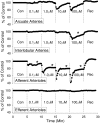
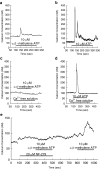
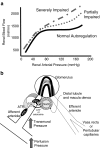
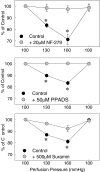
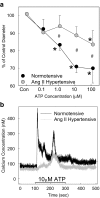
Similar articles
-
Renal microvascular effects of P2 receptor stimulation.Clin Exp Pharmacol Physiol. 2001 Apr;28(4):332-9. doi: 10.1046/j.1440-1681.2001.03450.x. Clin Exp Pharmacol Physiol. 2001. PMID: 11339210 Review.
-
P2 receptors in regulation of renal microvascular function.Am J Physiol Renal Physiol. 2001 Jun;280(6):F927-44. doi: 10.1152/ajprenal.2001.280.6.F927. Am J Physiol Renal Physiol. 2001. PMID: 11352833 Review.
-
P2X receptors as regulators of the renal microvasculature.Trends Pharmacol Sci. 2007 Dec;28(12):646-52. doi: 10.1016/j.tips.2007.09.010. Epub 2007 Nov 19. Trends Pharmacol Sci. 2007. PMID: 18022254 Review.
-
Purinoceptor-mediated regulation of the renal microvasculature.J Auton Pharmacol. 1996 Dec;16(6):385-8. doi: 10.1111/j.1474-8673.1996.tb00059.x. J Auton Pharmacol. 1996. PMID: 9131422 Review.
-
Role of adenosine 5'-triphosphate in regulating renal microvascular function and in hypertension.Hypertension. 2011 Sep;58(3):333-40. doi: 10.1161/HYPERTENSIONAHA.110.155952. Epub 2011 Jul 18. Hypertension. 2011. PMID: 21768526 Free PMC article. Review.
Cited by
-
Effect of P2X4 and P2X7 receptor antagonism on the pressure diuresis relationship in rats.Front Physiol. 2013 Oct 25;4:305. doi: 10.3389/fphys.2013.00305. eCollection 2013. Front Physiol. 2013. PMID: 24187541 Free PMC article.
-
P2 receptors in renal pathophysiology.Purinergic Signal. 2009 Dec;5(4):513-20. doi: 10.1007/s11302-009-9153-3. Epub 2009 Jun 9. Purinergic Signal. 2009. PMID: 19507052 Free PMC article.
-
Phenotypic diversity and metabolic specialization of renal endothelial cells.Nat Rev Nephrol. 2021 Jul;17(7):441-464. doi: 10.1038/s41581-021-00411-9. Epub 2021 Mar 25. Nat Rev Nephrol. 2021. PMID: 33767431 Free PMC article. Review.
-
Ectonucleotidases in the kidney.Purinergic Signal. 2009 Dec;5(4):501-11. doi: 10.1007/s11302-009-9152-4. Epub 2009 Mar 31. Purinergic Signal. 2009. PMID: 19333785 Free PMC article.
-
P2X1 receptor-mediated vasoconstriction of afferent arterioles in angiotensin II-infused hypertensive rats fed a high-salt diet.Hypertension. 2011 Apr;57(4):780-7. doi: 10.1161/HYPERTENSIONAHA.110.168955. Epub 2011 Feb 14. Hypertension. 2011. PMID: 21321307 Free PMC article.
References
-
- {'text': '', 'ref_index': 1, 'ids': [{'type': 'PubMed', 'value': '10869730', 'is_inner': True, 'url': 'https://pubmed.ncbi.nlm.nih.gov/10869730/'}]}
- Bailey MA, Hillman KA, Unwin RJ (2000) P2 receptors in the kidney. J Auton Nerv Syst 81:264–270 - PubMed
-
- {'text': '', 'ref_index': 1, 'ids': [{'type': 'PubMed', 'value': '11044209', 'is_inner': True, 'url': 'https://pubmed.ncbi.nlm.nih.gov/11044209/'}]}
- Bailey MA, Imbert-Teboul M, Turner C, Marsy S, Srai K, Burnstock G, Unwin RJ (2000) Axial distribution and characterization of basolateral P2Y receptors along the rat renal tubule. Kidney Int 58:1893–1901 - PubMed
-
- {'text': '', 'ref_index': 1, 'ids': [{'type': 'PubMed', 'value': '15056981', 'is_inner': True, 'url': 'https://pubmed.ncbi.nlm.nih.gov/15056981/'}]}
- Bailey MA, Turner CM, Hus-Citharel A, Marchetti J, Imbert-Teboul M, Milner P, Burnstock G, Unwin R (2004) P2Y receptors present in the native and isolated rat glomerulus. Nephron Physiol 96:79–90 - PubMed
-
- {'text': '', 'ref_index': 1, 'ids': [{'type': 'PubMed', 'value': '9575906', 'is_inner': True, 'url': 'https://pubmed.ncbi.nlm.nih.gov/9575906/'}]}
- Chan CM, Unwin RJ, Bardini M, Oglesby IB, Ford APDW, Townsend-Nicholson A, Burnstock G (1998) Localization of the P2X1 purinoceptors by autoradiography and immunohistochemistry in the rat kidney. Am J Physiol Renal Physiol 274:F799–F804 - PubMed
-
- {'text': '', 'ref_index': 1, 'ids': [{'type': 'PubMed', 'value': '9639035', 'is_inner': True, 'url': 'https://pubmed.ncbi.nlm.nih.gov/9639035/'}]}
- Chan CM, Unwin RJ, Burnstock G (1998) Potential functional roles of extracellular ATP in kidney and urinary tract. Exp Nephrol 6:200–207 - PubMed
Grants and funding
LinkOut - more resources
Full Text Sources

